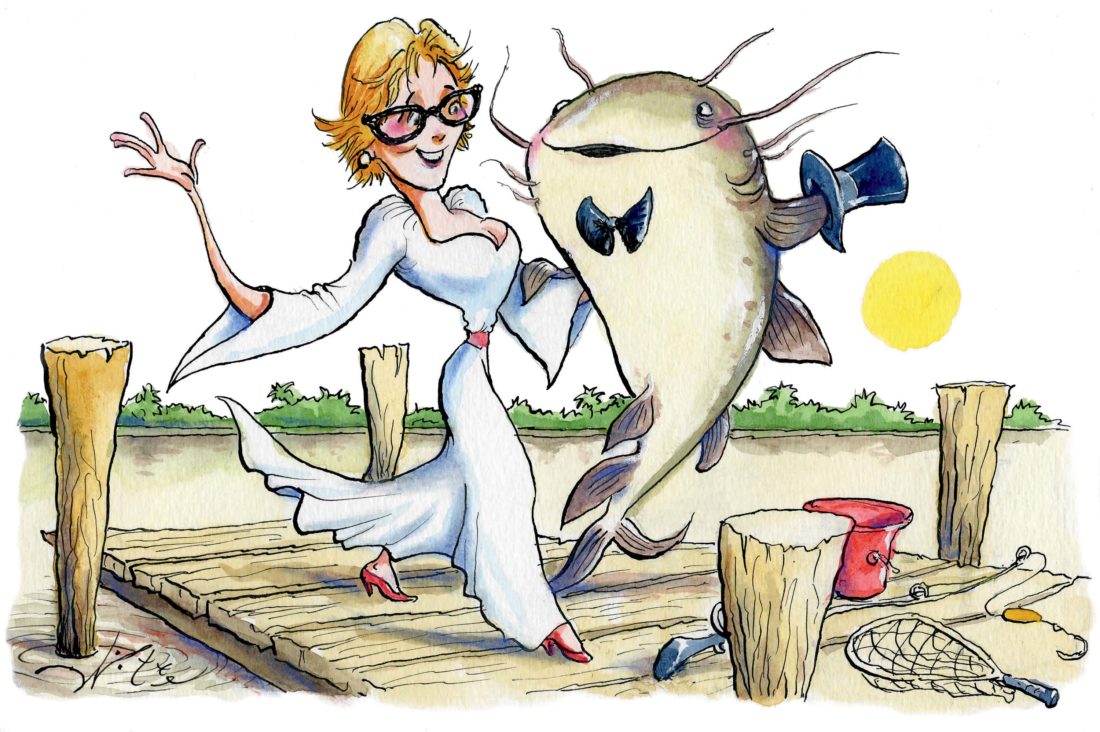Years ago, sometime around the mid-1980s, the Catfish Farmers of America asked me if I’d be willing to represent them in the Mobile Mardi Gras parade, where I would ride on a float and reign as Catfish Queen. I was living in Washington, D.C., and writing for U.S. News & World Report, and that sounded (correctly) like something happening on another planet, so I politely declined. Looking back, I find it unimaginable that I did not jump at the chance. My father couldn’t believe it at the time—but then he’s always found the whole concept of what he calls “titled women” wildly entertaining. You know: Miss Pink Tomato, Queen of the Turtle Derby, Poultry Princess, and so on. We have a lot of them down here. Miss Pink Tomato (along with Teen Miss Pink Tomato and Little Miss Pink Tomato) has been crowned every year in Warren, Arkansas, since 1957. So why not a Catfish Queen?
Let me hasten to add that I have never exactly been the titled woman type—unless of course there was an actual title and an especially lovely English country house involved. Sadly, I am certain I was asked to be queen not because I was even remotely pageant material (you’ve got to compete for the “real” crown, after all), but based on my support of farm-raised catfish, an industry now worth about $450 million a year but which was fairly new at the time. The 1980s were not the kindest to cotton and soybean farmers in the Mississippi Delta, which prompted many of them to try their hands at the fledgling catfish business by converting their fields to ponds. Since 60 percent of U.S. farm-raised catfish are grown within a sixty-five-mile radius of Belzoni, Mississippi, just down the road from my hometown, Greenville, I wanted to do my part. I wrote my first piece showcasing the industry during my brief tenure as a business reporter for the Orlando Sentinel, and then, when I landed at U.S. News a short time later, I wrote another. Hence the CFA’s gratitude—when I declined to accept the title, they sent me a plaque instead.
Anyway, the marketers and lobbyists were clearly busy during this period. Ronald Reagan declared June 25, 1987, National Catfish Day. And now of course there is an official Catfish Queen—actually, she’s called Miss Catfish—who is properly chosen in the annual pageant in Belzoni during the World Catfish Festival in April. The contestants all have shiny hair and brightly glossed lips and curvy dresses that are usually red to match the roses they carry. Had I been in charge of the crown, it would have been made of two rhinestone catfish kissing in the middle with whiskers that move when you walk, but I missed my chance when I declined the float ride.
The fact is that I didn’t need the possibility of a crown or Reagan’s proclamation or, especially, a slew of titled women to solidify my love of catfish. For one thing, the cat is a mighty entertaining creature. It can be wily, hanging out on the bottom of lakes and rivers, hiding in the reeds or inside logs, where some of my crazier friends try to grab them, an entirely slimy (catfish don’t have scales) and very muddy enterprise that I enjoy watching but will never, ever participate in. Also, there are those fetching whiskers. After my ex-husband thoroughly botched a big birthday, he tried to make amends by giving me a giant gilded papier-mâché catfish with superdramatic whiskers I’d spotted, incongruously, in a fancy antique store in Charlottesville, Virginia. It had once done duty on a New Orleans Mardi Gras float, so ownership of it kind of brought everything full circle. For years it hung out atop a grand piano in my former house; now it serves as the mascot of (shameless plug) Reed Smythe & Company, a business my dear friend and fellow Mississippi Deltan Keith Smythe Meacham and I started in the spring.
Also, if the first solid food I remember eating was a hot tamale, the second had to have been a fried morsel of crispy, salty, cornmeal-crusted catfish, followed closely by a hush puppy and a forkful of slaw. Many decades later, I still can’t get enough of the stuff—when I’m home I hit the drive-through at Gino’s or get the Friday plate lunch at Jim’s Café, where the slaw is homemade and pretty damn perfect. I also accept all invitations to catfish fries, especially when the master fryer is a man named Dan Hammett, who makes the best fried catfish and hush puppies I’ve ever tasted. Every year at the Delta Hot Tamale Festival, so many of my astonishingly generous chef pals bring their time and talents (and yummy, yummy food) to Greenville. The only way I can think of to thank them is with a catfish fry with Dan manning the fryer. His hush puppies are ethereal, his fish crisp and expertly seasoned. I’ve seen him add lemon pepper and red pepper to his cornmeal, but even he can’t tell me exactly what the trick is. I think it must be like biscuits or pie dough—everything depends on the hand of the cook, and Dan’s timing with all that gurgling grease is clearly spot-on.
One of the chefs who regularly attends is James Beard Award winner Stephen Stryjewski, who is Donald Link’s partner in the Link Restaurant Group in New Orleans and just about the funniest, sweetest man who ever walked. Stephen has a mighty fine hand at catfish himself—six months after he opened Cochon in 2006, he developed a superlative version of catfish court bouillon that thankfully remains on the menu. Cochon is nominally a Cajun restaurant (albeit a very sophisticated one), and Cajun court bouillons are always roux based. But, Stephen says, “it was hot and steamy out, and I wanted the dish to be lighter and more about the fish and tomatoes and peppers and less about the typical roux-based version, which I love but tends to be more of a stick-to-your-ribs-type thing.” He also didn’t want the catfish to cook forever as in a stew, so he fries it first and then adds it to the sauce, finishing it with some bright herbs and grilled scallions. “The fresh parsley and mint add a counterpoint to the heat of the chiles, and the scallions boost the roasted vegetable flavor.” Stephen says he loves the taste and texture of catfish, but he is partial to the “muddy edge” of the “wild stuff.” I am too, but I would be remiss in my role as CFA cheerleader not to add that the farm-raised variety would do just fine in this dish.
Either way, it is a masterpiece. What follows is Stephen’s recipe the way he wrote it, but if you can’t get your hands on lard, bacon grease or even safflower oil would work fine. Hoppin’ John’s excellent stone-ground corn flour (which is also great on fried oysters) is available at hinsononline.com, and if I can’t find good tomatoes to roast, I use about four or five canned whole peeled ones. Stephen might wince, but I am also not above using some boxed fish stock in a pinch. No matter what, it’s a perfect summer/fall offering and a delicious homage to the noble cat.
Cochon’s Catfish Court Bouillon
Yield: 6 servings
INGREDIENTS
1 large onion, diced
6 oz. lard
¼ cup chopped raw garlic
2 red bell peppers, roasted, seeded, and peeled
2 green peppers, roasted, seeded, and peeled
2 poblano peppers, roasted, seeded, and peeled
1 jalapeño pepper, roasted, seeded, and peeled
3 medium-sized ripe tomatoes, roasted and peeled
1 head garlic, roasted and separated into peeled cloves
2 cups fish stock
½ cup red wine vinegar
Hot sauce, to taste
Salt and pepper, to taste
2 lb. small catfish fillets
2 cups Hoppin’ John’s Stone-Ground Corn Flour
¼ cup whole mint leaves
¼ cup whole Italian parsley leaves
4 scallions, grilled and sliced
1 lemon, halved
PREPARATION
In a large deep skillet or a sauté pan, sweat the onions in 2 ounces of the lard. When the onions are soft and just beginning to pick up color, stir in the chopped garlic. Cook, stirring, for a minute or so and set aside.
Place the peppers, tomatoes, and roasted garlic in the bowl of a food processor and pulse until a nice chunky consistency is achieved. Add to the onion and garlic mixture in the skillet. Stir in fish stock and vinegar and bring to a simmer. Let simmer for 30 minutes and season to taste with hot sauce and salt and pepper. It should be the consistency of a thick stew and have a nice balance of heat and vinegar.
Season the catfish with salt and pepper and dust liberally with corn flour. Shallow fry the catfish in the remaining lard. Add to the sauce along with mint, parsley, and scallions.
Taste to see if more hot sauce, salt, and/or pepper is needed. Sprinkle with lemon juice and serve with white rice.








